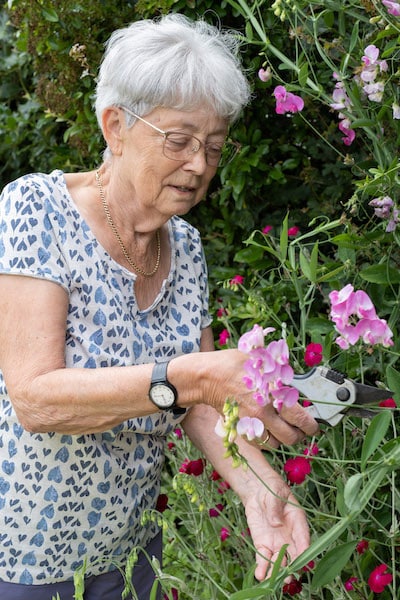Breathing Easier After Infection
|
Diana Turner

A retired business owner from Histon, England, Diana Turner, now 74, stays active gardening, swimming, hiking and bowling with her husband, Malcolm. She has a sweet laugh and a no-nonsense attitude – quintessentially British.
In 2005, just after celebrating her 60th birthday in London, Diana was watching her husband play indoor bowls when she started to feel a bit weak and tired.
“Someone was smoking near me, and my throat started to feel hot, and I just felt tired, so I left to go lie down,” she recalled.
She woke a few hours later with chest pains.
“I thought I might be having a heart attack,” Diana said. “But, I waited until morning to go to the doctor. My husband drove me, but the doctor took one look at me and called for an ambulance to take me to the hospital.”
The hospital performed routine cardiac exams and found nothing, so they sent her home. That night, she said she struggled to breathe, and when her daughter Caroline came to check on her the next morning, she called the ambulance. Diana was taken to the ICU.
“My dad phoned me and was very upset,” Caroline said. “When I arrived, mom was trying to breathe into a paper bag but was too panicked to really catch her breathe. It was quite scary.”
For two days, Diana doesn’t recall anything that happened, but the doctors diagnosed her with double pneumonia (an infection in both lungs) and pleurisy (an inflammation of the inner lining of the lungs that causes painful breathing.)
“I had never seen her look so pale and ill,” Caroline said. “She was in the ICU, and I thought, ‘My God, she’s not going to make it’.”
Fortunately, her mother received excellent emergency and post-acute care.
“I was treated with antibiotics and painkillers and within a week was back home,” Diana said. During this time, Diana had been taking care of her elderly father who still needed her, so she continued to care for him while trying to recover herself. She took short walks each day, increasing the distance to help her get her fitness level back up.
“I just couldn’t understand why I wasn’t better after a week,” Diana explained. “It took about six months to get back to normal. It goes to show that you do have to rest and let your body heal.”
Since her first bout with pneumonia, Diana has had two serious chest infections and was diagnosed with pneumonia again last year.
“The thing I find with pneumonia is it hits you really quick,” she described. “On a Friday, I had a cold and by Monday, I was coughing continually and my chest hurt. Now, the doctors have given me a pack of antibiotics and an inhaler. The minute I think I have a chest infection, I start taking them. I have to be careful.”
Diana still takes part in Aquafit twice a week, enjoys gardening and walking. While she and her husband continue to bowl in leagues, the pneumonia is still impacting her stamina.
Caroline said her family has become much more aware of the seriousness of infection, which is saying a lot, since Diana and Malcolm’s youngest daughter, Joanne, is a scientist and the Vice President for Research at Texas Biomed.
“I didn’t feel it was very serious, and I didn’t realize pneumonia still kills people,” Diana said.
She explained that the doctors still aren’t clear where the pneumonia originated and why she is more susceptible to it, but she is grateful to the scientists and physicians who are working on these diseases. Thanks to advances in new therapeutics and healthcare treatments, Diana is alive. Science gave her a future.
“Science is brilliant,” she said. “We are so lucky to have the information and healthcare we do.”
Caroline added that she believes the average person could benefit from knowing more about what scientists are doing to protect people, like her mother, from the threat of infectious diseases.
“To someone else, a sniffle is just a sniffle, but to mom, a mild cold can be quite serious and potentially life threatening,” she said. “You go to the doctors, get a prescription and take them and don’t think about all the work and research that goes on behind the scenes and the high cost. I think scientists could benefit from increased funding and awareness.”
100% of your donation goes to the TxBioMed Capital Campaign
Pilot Project
Science driven by you for you!
As America’s only independent, nonprofit research institute with a fully integrated primate research center and the highest level biosafety laboratories in the world on one campus, Texas Biomed aims to save lives as fast as possible.
Combining its regulated, ethically-run primate center and biosafety labs with the expertise of more than 75 scientists, the Institute is speeding up the development of vaccines and therapies for some of the world’s deadliest diseases.
With a vision to double the size of its workforce, recruit leading scientists in the field of infection and immunity and create a collaborative environment that advances discovery, Texas Biomed is transforming how innovations move from the lab to loved ones. Because, the goal is to eradicate infectious diseases, and give us all a healthier future!